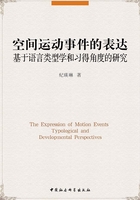
3.1.2 Encoding caused motion events in English
The present study focuses on the expression of both voluntary and caused motion events.We demonstrated above how the former is typically encoded in English; as regards the latter, the incorporation of the Cause component results in a ‘caused motion’ event in which an Agent does something to cause the displacement of a Figure in different manners and along different paths.According to Song and Wolff (2005: 239-243), although English has multiple means of encoding causation, such as conjunctions (e.g.because , since ), prepositions (e.g.because of , due to ), resultatives (e.g.He hammered the iron flat ) and periphrastic causatives (e.g.The wind causes the ball to roll down the table ), direct causation in the context of motion is typically encoded through the use of lexical causatives.More specifically, causative motion verbs usually encode Cause along with Manner of motion and the fact of motion (see (15a), below), but sometimes combine Cause with Path information and Motion per se(see (15b)) or combine Cause with Motion alone (see (15c)).
(15)a.He rolled [Cause + Motion + Manner] the ball down[Path] the hill .
b.He lifted [Cause + Motion + Path] the box upto [Path] the shelf .
c.He moved [Cause + Motion] the trunk across [Path] the pavement .
To summarize, caused motion events are frequently expressed in English as follows: verb roots encode Cause of motion in combination with Manner of motion, and particles or prepositions express Path of motion.